|
Today in New Orleans History |
|
|
October 28


Charles/Carlos
Matranga Dies Illustration "Scene
of the Assassination" in "The Mascot" newspaper, October 18, 1890. Shows location of the murder of police chief David Hennessy
and artist's conception of the event.
At top left is a portrait of Hennessy. Location was at Basin & Girod Streets (this section of Basin since renamed "Loyola
Avenue") Reputed New Orleans Mafia boss Charles/Carlos Matranga died on October 28, 1943
in Los Angeles of natural causes. The Matranga crime family, established by Charles (1857-28 October 1943)
and Antonio Matranga (Tony) was one of the earliest recorded American Mafia crime families, operating in New Orleans during
the late 19th century until the beginning of Prohibition in 1920. Born in Sicily, Carlo and Antonio
Matranga settled in New Orleans during the 1870s where they eventually opened a saloon and brothel. Using their business
as a base of operations, the Matranga brothers began establishing lucrative organized criminal activities including extortion
and labor racketeering. Receiving tribute payments from Italian laborers and dockworkers, as well as from the rival Provenzano crime family (who held a near monopoly of commercial shipping from South American fruit shipments),
they eventually began moving in on Provenzano fruit loading operations intimidating the Provenzanos with threats of violence.
Although the Provenzanos withdrew in favor of giving the Matrangas a cut of waterfront racketeering,
by the late 1880s, the two families eventually went to war over the grocery and produce businesses held by the Provenzanos.
As both sides began employing a large number of Sicilian mafiosi from their native Monreale, Sicily, the violent gang war
began attracting police attention, particularly from New Orleans police chief David Hennessy who began investigating into
the warring organizations. Within months of his investigation, Hennessy was shot and killed by several
unidentified attackers while walking home on the night of October 15, 1890. This was in keeping with the Mafia practice
of killing the government official who got in the Mafia's way. The murder of Hennessey created a huge backlash from the city
and, although Charles and several members of the Matrangas were arrested, they were eventually tried and acquitted in February
1891 with Charles Matranga and a 14-year-old member acquitted midway through the trial as well as four more who were eventually
acquitted and three others released in hung juries. The decision caused strong protests from residents,
angered by the controversy surrounding the case (particularly in the face of incriminating evidence and jury tampering),
and the following month a lynch mob stormed the jail hanging 11 of the 17 Matranga members still waiting to be brought to
trial including Antonio Bagnetto, Bastiano Incardona, Antonio
Marchese, Pietro Monastero and Manuel Politzi on March 14, 1891.
The Hennessey lynchings led to the American Mafia adopting a hard and fast rule that policemen and
other law enforcement officials were not to be harmed. Matranga was able to escape from the vigilante lynchings and, upon
returning to New Orleans, resumed his position as head of the New Orleans crime family eventually forcing the declining
Provenzanos out of New Orleans by the end of the decade. Matranga would rule over the New Orleans underworld until shortly
after Prohibition when he turned over leadership over to Sylvestro "Sam" Carollo
in the early 1920s. (Wiki)
Rees Architects, Inc. applied for a building permit for new construction at 846 Howard Avenue (WDSU-TV) on October 28, 1994.
Photo of Japan ZONTA Club members. Asian night, October 28, 1985.
Photo of the inside of the Dixie Drug Store at the corner of Erato Street and Loyola Avenue, October 28, 1943. Earlier that month, the owner of the store, druggist George Mansion, was shot during an armed robbery. He later died at Baptist Hospital. Parker Lloyd Adams was arrested for the murder. The photograph was taken by John T. Dahmen. Jazzman Walter Payton, Jr died on October 28, 2010. Born in New Orleans on
August 23, 1942, he played bass and sousaphone with the Preservation Hall Jazz Band,the French Market Jazz Hall Band and the
Young Tuxedo Brass Band, and led his own group called the Snap Bean Band. His recording credits include Lee Dorsey's "Working
in the Coal Mine", and Payton variously worked with Aaron Neville, Harry Connick Jr., Champion Jack Dupree and Chuck
Carbo. Payton died in his hometown of New Orleans, after an illness, aged 68. He was the father of jazz trumpet player Nicholas
Payton. John William Corrington (October 28, 1932 – November 24, 1988)
was an American film and television writer, novelist, poet and lawyer. He received a B.A. degree from Centenary College, in
1956 and his M.A. from Rice University in 1960, the year he took on his first teaching position in the English Department
at Louisiana State University. While on leave from LSU, Corrington obtained his D.Phil. in 1965, from the University of Sussex
and then moved to Loyola University New Orleans in 1966, as an Associate Professor of English, where he also served as chair
of the English Department. Corrington graduated from Tulane University Law School in 1975, joined a small New Orleans personal
injury law firm, Plotkin and Bradley, and spent the next three years practicing law. During this time Corrington published
four books of poetry, Where We Are (1962), The Anatomy of Love (1964), Mr. Clean (1964) and Lines to the South (1965). With
Miller Williams, Corrington edited Southern Writing in the Sixties: Fiction (1966) and Southern Writing in the Sixties: Poetry
(1967). Corrington also published four books of short stories, The Lonesome Traveler (1968), The Actes and Monuments (1978),
The Southern Reporter (1981) and All My Trials (1987) and four novels, And Wait for the Night (1964), The Upper Hand (1967),
The Bombardier (1970) and Shad Sentell (1984). He won an Award in Fiction from the National Endowment for the Arts and had
a story included in the O. Henry Award Stories (1976) and three in the Best American Short Stories series, (1973, 1976 and
1977). With his wife, Joyce Hooper Corrington, Corrington wrote five screenplays, Von Richthofen and Brown (1969), The Omega
Man (1970), Boxcar Bertha (1971), The Arena (1972) and Battle for the Planet of the Apes (1973) and a television film, The
Killer Bees (1974). Corrington gave up the practice of law in 1978 and he and his wife, Joyce Corrington, became head
writers for daytime serials. The Corringtons scripted Search for Tomorrow (1978–80), Another World (1980), Texas (1980–81),
General Hospital (1982; hired by Gloria Monty), Capitol (1982–83, hired by John Conboy) and One Life to Live (1984).
They also wrote and produced Superior Court, a syndicated series (1986–89). Texas and Superior Court were each nominated
twice for a Daytime Emmy Award. During this time, the Corringtons also published So Small a Carnival (1986), A Project Named
Desire (1987), A Civil Death (1987) and The White Zone (1990). After Bill Corrington's death, his novella, "Decoration
Day", was adapted as a Hallmark Hall of Fame television special (1990), which was nominated for an Emmy and won a Christopher
Award and a Golden Globe award. The Collected Stories of John William Corrington was published in 1990, by the University
of Missouri Press. (Wiki)
Dixieland jazz pianist, clarinetist, and drummer Ollie "Dink"
Johnson (October 28, 1892 – November 29, 1954) was a was born in Biloxi, the younger
brother of the bass player/bandleader William Manuel Johnson. He worked around Mississippi and New
Orleans before moving out west in the early 1910s. He played in Nevada and California, often with his brother Bill.
Most prominently he played with the Original Creole Orchestra (mostly on drums). He also played clarinet
in Kid Ory's band. For many years he was based in Los Angeles where he led a band in the
1920s and later ran a bar called Dink's Place at 4429 Avalon Blvd. He was visited there in March 1946 by Bill Russell, who
organised most of his piano and one man band recordings. Russell wrote in his diary that Dink had a room at the back for
selling bootleg whisky, and kept a gun in a saucepan "because the police would never look there". He told Russell
that he had "always lived outside the law." He made his first recordings in 1922 on clarinet with Kid Ory's Band.
He made more recordings in the 1940s and 1950s, mostly on piano, although also doing some one-man band recordings, playing
all three of his instruments through over dubbing. Johnson's piano style was influenced by Jelly Roll Morton (his brother-in-law);
his clarinet playing by Larry Shields. Johnson also wrote tunes, including "The Krooked Blues" (recorded
by King Oliver) and "So Different Blues" . (From wikipedia)
Born in New Orleans on October 28, 1785, Bernard Xavier Philippe de Marigny
de Mandeville (also known as Bernard de Marigny), was a French-Creole American nobleman,
playboy, politician, and President of the Louisiana Senate between 1822-1823.
He died on February 3, 1868 in New Orleans, he is buried in St. Louis Cemetery No. 1. More information.
It was under construction from 1964 to 1968,
at a cost of $25 million. By 1994, this building was estimated to be worth $300 million. The Rivergate had pedestrian
entrances on Canal and Poydras Streets and Convention Center Boulevard. The South Peters Street elevation was dedicated
to entrance and exit openings for the two-level subsurface 800-automobile parking garage, a long loading dock with two
access doors 20' x 20' to the first floor, and freight elevators. The caption for the postcard (above) reads: The
RIVERGATE, which covers six city squares, located where famed Canal Street meets the Mississippi River, is one of the most
uniquely constructed convention-exhibition halls in the country. Boasting 130,000 square feet of clear, unobstructed space,
with no posts or pillars; it is capable of seating more than 16,000 persons for an assembly or meeting with 733 - 10'
x 10' exhibit spaces, or a combination of both. This 13 1/2 million dollar ($13,500,000) structure will be one of the
nation's newest and finest facilities". Ground breaking ceremonies on December 4, 1964
were followed by the driving of piles and a deep excavation to provide space for the parking garage, mechanical and electrical
equipment, stairs and escalators to move people from subsurface levels up to the first floor, and the tunnel 60' x
750' ($1.3 million). Although the Rivergate was conceived and designed as a convention-exhibition facility, it
was also used as the venue for Mardi Gras balls, high school graduations, and the lying in state of New Orleans native
Mahalia Jackson in 1972). But like the Municipal Auditorium, the Rivergate became obsolete in its usefulness as a convention
and exhibition center. The Ernest N. Morial Convention Center was being planned in 1978. As of 2006, it
has about 1.1 million square feet of exhibit space, covering almost 11 blocks, and over 3 million square feet of total space.
It is the 5th-largest facility of its kind in the United States and would dwarf the old Rivergate. The
City of New Orleans then altered the zoning ordinances to allow construction of a casino at the Rivergate site.
The city issued a call for casino proposals due on August 14, 1992 which required a $50,000 payment
for the privilege of submitting a proposal, half of which was refundable to unsuccessful bidders. On November
5, 1992, Mayor Sidney Barthelemy and the City Council picked Christopher Hemmeter-Caesar's Palace (known as
the Grand Palais group) to lease the city-owned Rivergate site for development of a casino. The lease was signed
on April 27, 1993. Subsequently, the Casino Board awarded the casino operator's license to Harrah's Jazz, a partnership
of Harrah's and the Jazzville group (all local investors). On April 15, 1993, Mayor Barthelemy
and the City Council finalized the selection of Hemmeter as the "developer" -- he later teamed with Caesar's
World of Las Vegas to operate the casino in a renovated Rivergate but soon the Hemmeter-Caesar's group proposed its demolishion
to make way for a new building called Grand Palais. This plan would include a twenty-two-inch deep pond, called
Celebration Lake which would run across the foot of Canal Street, ending at One Canal Place. And there would be a sound
and laser-light show and much more including a recreation of Bernard the colonnaded arcades at the Palace of Fine Arts in
San Francisco. In the end, the only elements of the Grand Palais scheme that were constructed were the "Casino
Support Facility" -- a ten-leve, 2 1/2 block long parking garage) which replaced a group of nineteenth-century buildings
at the corner of Poydras and South Peters Streets and the tunnel linking it to the casino. But everything else fell
through. The official "wall-breaking" ceremony took place on Friday, January 13, 1995.
On this occasion, a back hoe equipped with a claw toothed bucket and a "Harrah's" banner draped on its back
climbed up the steps at the Canal-South Peters Streets entrance and began wrecking the underside of the cement plaster
entrance canopy. Much of the concrete debris was hauled to West End at Lake Pontchartrain to be used as fill for
enlargement of a park off Breakwater Drive. Although only reinforced concrete was supposed to be dumped there, other
debris was included. The nature of the debris stirred environmentalists and their protests stopped the dumping at the
West End site. On October 28, 1999, Harrah's Casino was completed at the foot of Canal Street,
three years behind schedule. From THE RIVERGATE (1968 - 1995) Architecture And Politics -- No Strangers In Pair-A-Dice His other professional contributions as a producer and arranger
for studio, film, stage and television include Joe Jones' "You Talk Too Much", Lee Dorsey's
"Ya Ya", and Sonny and Cher's "I Got You Babe". Battiste introduced
audiences to New Orleans artist Mac Rebennack as Dr. John, and produced his earliest albums. He also spent thirty
years in Los Angeles, including fifteen years with Sonny and Cher, earning six gold records, and acting as musical
director on their TV series. Harold also played piano for Tom Waits's songs Whistlin'
Past The Graveyard and A Sweet Little Bullet From A Pretty Blue Gun on Blue Valentine (1978). Battiste has also been a lecturer
at several colleges, and in 1989, he joined Ellis Marsalis on the Jazz Studies faculty of the University
of New Orleans. He has now established the AFO Foundation, a non-profit service and educational organization
dedicated to recognizing, perpetuating and documenting the heritage of New Orleans music and the people who make the music. Battiste remains active in the
community and has served as a board member of the Congo Square Cultural Collective, the Louisiana State Music Commission,
New Orleans Jazz and Heritage Foundation, Louisiana Jazz Federation, the African Cultural Endowment and numerous other cultural
organizations. He has received the Beau Arts Award, the Mayor's Arts Award, the Governor's Arts Lifetime Achievement Award
and many others. In 1998, the City of New Orleans proclaimed his birthday as Harold Battiste Day. In 2010 the Historic New
Orleans Collection published his autobiography Unfinished Blues. Photo of Harold Battiste at Satchmo
SummerFest, August 4, 2012, by Infrogmation of New Orleans |
|
|

To receive an update for each day in New Orleans history,
join our facebook page - Today in New
Orleans History.
Analytics |

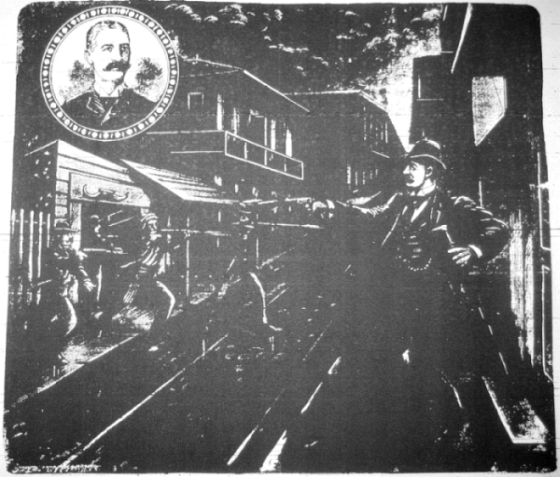

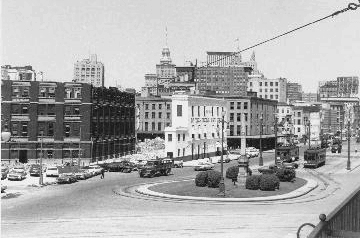
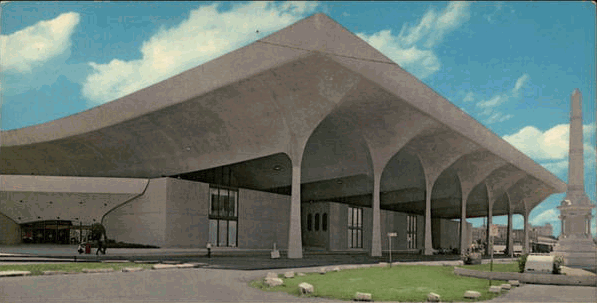 The Rivergate was designed by the local firm Curtis and Davis (Nathaniel Cortlandt Curtis Jr. (1917–1997) and Arthur
Quentin Davis (1920–2011) who had also designed the Thomy Lafon School (1954) and the Louisiana State Penitentiary
at Angola (1956) and would later design the Superdome. The undulating forms of the Rivergate's thin barrel
vaults were not whimsical but are the precise shape necessary to manage the unusually long spans required for the roof
over the column free space below. The cantilevers all around contribute to the stability of the roof structure. The selection
of six temple like bays utilized to the limit the spans between columns; the columns themselves are slender and graceful,
suited to the task of support. The Rivergate, while it stood in New Orleans, was looked upon by many as a significant
example of outstanding national and international contemporary architecture and was compared to the recognized masterpieces
of its period. The most distinguishing feature of the Rivergate was the roof. The 95,500-sq. foot South Hall
was covered by a swooping and sweeping dual curved roof. This reinforced concrete barrel-arched roof design was symbolic
of the rolling Mississippi River which flows about 500 feet from the building. Engineering News Record referred to
these "humpbacked" 1-1/2 catenary curve barrel arches 453 ft. long as having the profile of a whale. The Rivergate
roof was perhaps the longest thin shell concrete roof span that had been constructed at that time. The 34,500-sq. foot
North Hall, later called Penn Hall, in honor of its distinguished and successful manager, Herman Penn, was spanned
by steel trusses 6' deep and covered with a flat roof.
The Rivergate was designed by the local firm Curtis and Davis (Nathaniel Cortlandt Curtis Jr. (1917–1997) and Arthur
Quentin Davis (1920–2011) who had also designed the Thomy Lafon School (1954) and the Louisiana State Penitentiary
at Angola (1956) and would later design the Superdome. The undulating forms of the Rivergate's thin barrel
vaults were not whimsical but are the precise shape necessary to manage the unusually long spans required for the roof
over the column free space below. The cantilevers all around contribute to the stability of the roof structure. The selection
of six temple like bays utilized to the limit the spans between columns; the columns themselves are slender and graceful,
suited to the task of support. The Rivergate, while it stood in New Orleans, was looked upon by many as a significant
example of outstanding national and international contemporary architecture and was compared to the recognized masterpieces
of its period. The most distinguishing feature of the Rivergate was the roof. The 95,500-sq. foot South Hall
was covered by a swooping and sweeping dual curved roof. This reinforced concrete barrel-arched roof design was symbolic
of the rolling Mississippi River which flows about 500 feet from the building. Engineering News Record referred to
these "humpbacked" 1-1/2 catenary curve barrel arches 453 ft. long as having the profile of a whale. The Rivergate
roof was perhaps the longest thin shell concrete roof span that had been constructed at that time. The 34,500-sq. foot
North Hall, later called Penn Hall, in honor of its distinguished and successful manager, Herman Penn, was spanned
by steel trusses 6' deep and covered with a flat roof. 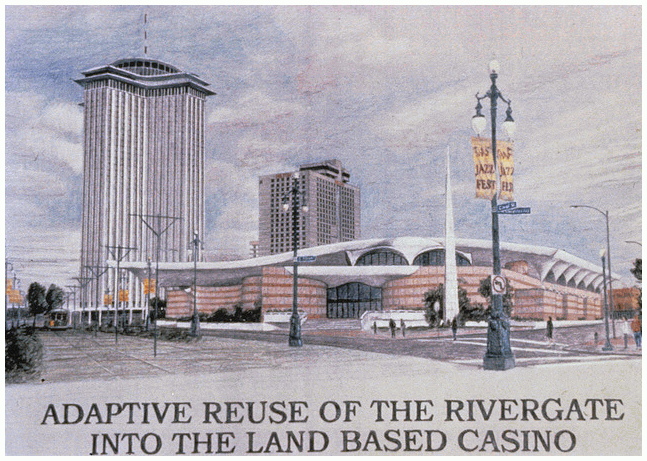 In June 1992, Louisiana House Bill 2010 (Act 384 of the 1992 Regular Session) authorized a land-based casino in New Orleans.
The legislation specifically defined the location of the land-based casino -- the Rivergate site at the foot of Canal
Street. The law did not require the Rivergate to be torn down, and it did not require a new casino to be built.
In June 1992, Louisiana House Bill 2010 (Act 384 of the 1992 Regular Session) authorized a land-based casino in New Orleans.
The legislation specifically defined the location of the land-based casino -- the Rivergate site at the foot of Canal
Street. The law did not require the Rivergate to be torn down, and it did not require a new casino to be built.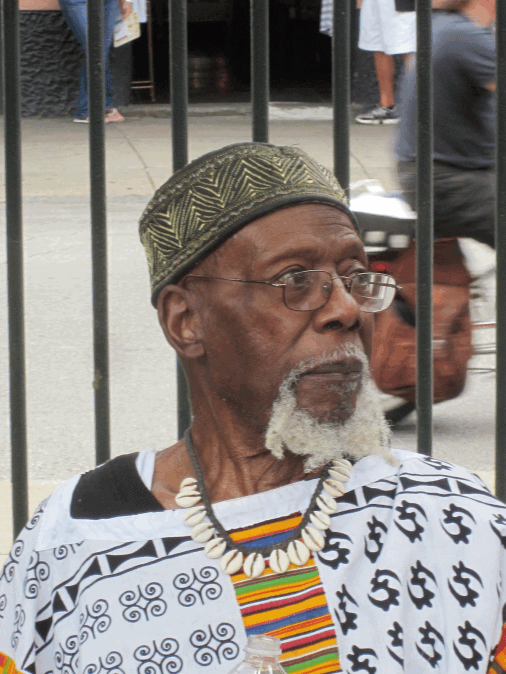 Harold
Battiste was born in New Orleans on October 28, 1931.
He attended
Harold
Battiste was born in New Orleans on October 28, 1931.
He attended 
